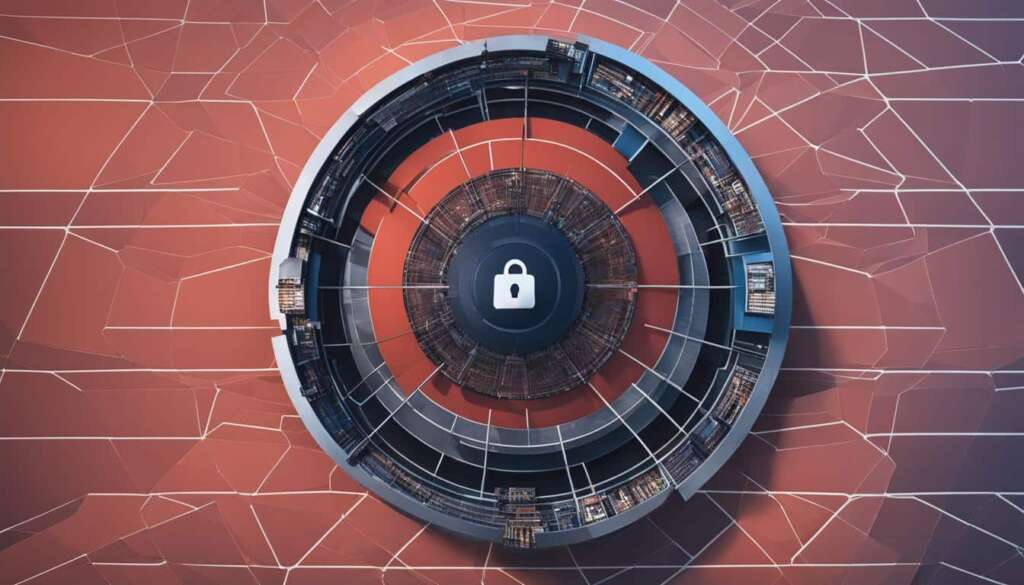Table of Contents
With the rise of the collaborative economy, the need for cybersecurity has become increasingly important. Cybercriminals pose significant threats to the security and privacy of online shared spaces. Securing these spaces is essential to protect users and prevent cybercrime.
The collaborative economy has emerged as a new economic model where consumers use technology to provide, buy, sell, share, or rent goods and services. However, in this interconnected digital landscape, secure online transactions and data protection are paramount.
As more individuals and businesses participate in the collaborative economy, the risk of cyber threats increases. Without robust cybersecurity measures in place, sensitive information and financial transactions are vulnerable to attacks.
In this article, we will explore the importance of cybersecurity in the collaborative economy and discuss strategies for securing shared digital spaces. From understanding the cybercriminal ecosystem to promoting trust and security in collaborative platforms, we will delve into various aspects of protecting users and their data.
Join us as we examine the role of collaboration in cybersecurity, address regulatory challenges, educate users about cybersecurity risks, and build a resilient cybersecurity infrastructure. Discover the future trends that will shape cybersecurity in the collaborative economy and the significance of international collaboration in combating cybercrime.
Stay tuned for valuable insights and practical advice on how to navigate the evolving cybersecurity landscape and ensure a safe and prosperous collaborative economy.
Understanding the Cybercriminal Ecosystem
The collaborative economy may offer numerous benefits, but it also opens the door to various cyber threats. To effectively combat these threats, it is crucial to understand the cybercriminal ecosystem. The Cybercrime Atlas, an initiative by the World Economic Forum’s Partnership Against Cybercrime, provides a valuable platform for sharing knowledge and insights about the ecosystem.
The cybercriminal ecosystem is a lucrative business, costing trillions of dollars globally. By studying this ecosystem, cybersecurity practitioners can gain a comprehensive understanding of the common patterns and trends that cybercriminals exploit. This knowledge enables them to devise robust strategies to mitigate risks, safeguard shared digital spaces, and protect users from cyber threats.
The Cybercrime Atlas helps cybersecurity experts identify the key players in the cybercriminal ecosystem, such as hackers, malware developers, and money launderers. It sheds light on their tactics, motivations, and targets, aiding in the development of effective risk management strategies.
By delving into the cybercriminal ecosystem, experts can gain valuable insights into the evolving tactics and techniques used by cybercriminals. This understanding enables them to stay one step ahead and devise proactive measures to protect the collaborative economy from cyber threats.
To summarize, understanding the cybercriminal ecosystem is essential for effective risk management in the collaborative economy. By studying the Cybercrime Atlas and staying updated on emerging cyber threats, cybersecurity practitioners can develop robust strategies to secure shared digital spaces and protect users from cybercriminals.
The Role of Collaboration in Cybersecurity
Collaboration plays a pivotal role in addressing cybersecurity challenges in the collaborative economy. With the increasing reliance on technology and the rapid growth of online shared spaces, it is crucial for different stakeholders to work together to ensure secure digital collaborations. By sharing information, expertise, and resources, governments, companies, law enforcement agencies, and cybersecurity companies can develop effective strategies to mitigate risks and improve cybersecurity measures.
One of the key aspects of collaboration in cybersecurity is the sharing of information. By exchanging knowledge and insights, stakeholders can gain a better understanding of emerging cyber threats and vulnerabilities. This shared intelligence allows for proactive measures to be taken, such as timely threat detection and response, thereby preventing potential cyber attacks and minimizing their impact.
Collaboration also enables the development of comprehensive cybersecurity frameworks and standards. Through collective efforts, stakeholders can establish guidelines and best practices that address the specific cybersecurity needs of the collaborative economy. These frameworks can include protocols for secure transactions, data protection measures, and protocols for incident response and recovery.
Benefits of Collaboration in Cybersecurity
The benefits of collaboration in cybersecurity are numerous. By working together, stakeholders can pool their resources and expertise to create a more robust defense against cyber threats. Collaboration allows for the identification and sharing of best practices, enabling organizations to implement effective cybersecurity measures. It also facilitates the exchange of information on emerging technologies and trends, ensuring that stakeholders stay ahead of cybercriminals.
Moreover, collaboration fosters trust and confidence among users in the collaborative economy. When multiple stakeholders come together to address cybersecurity concerns, it sends a powerful message that the safety and security of online shared spaces are of paramount importance. This, in turn, encourages users to engage more actively in the collaborative economy, driving its growth and sustainability.
Table: Examples of Collaborative Cybersecurity Initiatives
| Initiative | Description |
|---|---|
| Cybersecurity Information Sharing and Analysis Centers (ISACs) | Industry-specific organizations that facilitate information sharing and collaboration on cybersecurity threats and vulnerabilities. |
| Public-Private Partnerships | Collaborative initiatives between governments and private sector entities to address cybersecurity challenges in critical sectors. |
| International Cybersecurity Cooperation | Efforts by different countries to collaborate and share information on cyber threats, cybercrime investigations, and incident response. |
| Research and Development Collaborations | Academic institutions, cybersecurity companies, and government agencies collaborating on research projects to develop innovative cybersecurity solutions. |
Securing Critical Infrastructure in the Collaborative Economy
The collaborative economy heavily relies on critical infrastructure to facilitate seamless transactions and interactions among users. However, the interconnected nature of this infrastructure also makes it vulnerable to cyber threats. It is essential to implement robust cybersecurity measures to protect critical infrastructure and ensure the smooth functioning of the collaborative economy.
One of the key steps in securing critical infrastructure is the implementation of strong encryption protocols. Encrypting data transmitted through the collaborative platforms adds an extra layer of protection, making it harder for cybercriminals to intercept and exploit sensitive information. Regular system updates are also crucial, as they address vulnerabilities and ensure that the infrastructure is equipped with the latest security patches.
Employee training is another vital aspect of securing critical infrastructure. Cybersecurity courses and training programs should educate employees about cybersecurity best practices, such as identifying phishing attempts, using strong passwords, and being cautious of suspicious activities.. By creating a cybersecurity-aware workforce, organizations can significantly reduce the risk of cyber attacks on critical infrastructure.
Table: Examples of Essential Cybersecurity Measures for Critical Infrastructure
| Critical Infrastructure | Cybersecurity Measures |
|---|---|
| Transportation Systems | Implement secure communication protocols, regularly update software and firmware, conduct audits and penetration testing. |
| Energy Grids | Deploy intrusion detection systems, establish secure access controls, conduct regular risk assessments, monitor and analyze network traffic. |
| Communication Networks | Use robust encryption algorithms, implement firewalls and intrusion prevention systems, train employees on identifying and reporting security incidents. |
By implementing these cybersecurity measures, the collaborative economy can safeguard critical infrastructure from cyber threats and ensure the uninterrupted delivery of essential services. However, it is essential to continually monitor and adapt security measures to keep up with the evolving threat landscape and stay one step ahead of cybercriminals.

Promoting Trust and Security in Collaborative Platforms
Trust and security are paramount in the collaborative economy, where users rely on digital platforms to engage in shared transactions and interactions. To build trust among users, collaborative platforms must prioritize data protection, online privacy, and secure digital collaborations. By implementing robust security measures and transparent policies, these platforms can create a safe and secure environment for their users.
One key aspect of promoting trust and security is the implementation of strong encryption protocols. Collaborative platforms should utilize encryption technology to protect user data and ensure that sensitive information remains secure during online transactions. Additionally, secure login protocols, such as two-factor authentication, can enhance security and safeguard user accounts.
Transparency is another critical factor in building trust. Collaborative platforms should have clear and user-friendly data protection policies that outline how user data is collected, stored, and used. By providing transparency regarding data practices, platforms can instill confidence in users and alleviate concerns about privacy.
Furthermore, education plays a crucial role in promoting trust and security. Collaborative platforms should invest in user awareness programs that educate users about the potential risks they may encounter and provide guidance on how to protect themselves online. By empowering users with knowledge, platforms can help users make informed decisions and mitigate security threats.
Table: Trust and Security Measures in Collaborative Platforms
| Trust and Security Measures | Description |
|---|---|
| Encryption | Utilize strong encryption protocols to protect user data and ensure secure online transactions. |
| Secure Login Protocols | Implement secure login methods, such as two-factor authentication, to enhance user account security. |
| Data Protection Policies | Have transparent and user-friendly policies regarding data collection, storage, and usage. |
| User Awareness Programs | Invest in educational initiatives to raise user awareness about online security risks and best practices. |
Addressing Regulatory Challenges in the Collaborative Economy
The regulatory landscape in the collaborative economy presents unique challenges when it comes to data protection and online transactions. With the global nature of collaborative platforms, enforcing regulatory measures and ensuring the safety and privacy of users’ data becomes a complex task. Governments and regulatory bodies must work together to develop comprehensive frameworks that address these challenges and protect the interests of users.
One of the key regulatory challenges is establishing clear guidelines for data protection. Collaborative platforms handle vast amounts of user data, including personal information and transaction details. It is essential to have regulations in place that outline the responsibilities of these platforms in safeguarding user data and ensuring its secure handling. This includes measures such as encryption, data minimization, and user consent for data processing.
“Regulatory frameworks need to strike a balance between fostering innovation in the collaborative economy and protecting users’ rights and privacy.”
Another regulatory challenge is ensuring the security of online transactions in the collaborative economy. With the rise of peer-to-peer transactions, it is crucial to establish trust and confidence among users. Regulatory frameworks should focus on developing standard security protocols, secure payment gateways, and dispute resolution mechanisms that protect both buyers and sellers in online transactions.
Regulatory Compliance and Collaborative Platforms
Collaborative platforms must comply with these regulatory measures to ensure the safety and privacy of their users. This includes implementing robust security measures, conducting regular audits and assessments of their data protection practices, and providing transparent information about their security protocols. By adhering to these regulations, collaborative platforms can build trust among their users and foster a secure environment for online interactions.
| Regulatory Challenges | Data Protection | Online Transactions |
|---|---|---|
| Lack of clear guidelines | Establish responsibilities for data protection | Develop standard security protocols |
| Global nature of collaborative platforms | Implement encryption and data minimization | Secure payment gateways |
| Ensuring trust in online transactions | User consent for data processing | Dispute resolution mechanisms |
Addressing regulatory challenges is crucial for the long-term success and sustainability of the collaborative economy. It requires collaboration between governments, regulatory bodies, and collaborative platform operators to create a harmonized regulatory environment that protects users’ data, ensures secure online transactions, and fosters innovation in the digital marketplace.

User Awareness: The Key to Cybersecurity Education
In today’s digital age, where online threats continue to evolve and become more sophisticated, educating users about cybersecurity risks is crucial. By raising awareness and providing necessary knowledge, we can empower individuals to protect themselves and their personal information in the collaborative economy. Cybersecurity education plays a vital role in equipping users with the skills and awareness needed to navigate the online world securely.
One of the first steps in cybersecurity education is to educate users about the common online threats they may encounter. From phishing attacks to malware and social engineering, understanding these tactics can help users identify and avoid potential dangers. By providing real-life examples and case studies, users can develop a better understanding of the risks and learn how to recognize and respond to them effectively.
Additionally, cybersecurity education should cover best practices for securing personal devices and accounts. This includes creating strong and unique passwords, enabling two-factor authentication, keeping software and applications up to date, and being cautious when downloading or sharing files. By instilling these habits, users can significantly reduce their vulnerability to cyber attacks.
Furthermore, teaching users about the importance of regularly backing up their data and recognizing the signs of a compromised system is critical. By encouraging users to regularly back up their files, they can minimize the impact of potential data breaches or ransomware attacks. Additionally, educating users about the warning signs of a compromised system, such as unusual network activity or unexpected system behavior, can help them take immediate action and prevent further damage.
The Role of Collaboration in Cybersecurity Education
Cybersecurity education cannot be achieved in isolation; it requires collaboration between multiple stakeholders. Governments, educational institutions, businesses, and cybersecurity experts must work together to design comprehensive educational programs that address the diverse needs of users. By pooling resources and expertise, we can develop engaging and informative educational materials and initiatives that reach a wide audience.
Collaboration also extends to industry partnerships, where technology companies and cybersecurity providers can play a crucial role in promoting user awareness. By integrating security features into their products and offering user-friendly tools, these companies can empower users to protect themselves effortlessly. For example, browsers that display warnings for potentially unsafe websites or email providers that have robust spam filters can significantly enhance user security.
In conclusion, cybersecurity education and user awareness are vital in combating online threats in the collaborative economy. By equipping users with the knowledge and skills to recognize and respond to cyber threats, we can create a safer online environment. Collaboration among stakeholders, along with the integration of security features into products and services, will strengthen cybersecurity education efforts and contribute to a more secure digital landscape.
Building a Resilient Cybersecurity Infrastructure
In order to effectively address the cybersecurity challenges in the collaborative economy, it is crucial to build a resilient cybersecurity infrastructure. Such an infrastructure ensures that organizations are prepared to respond to and mitigate cyber threats effectively. Resilient cybersecurity involves a comprehensive approach to risk management and digital security, encompassing advanced threat detection systems, regular risk assessments, and robust incident response plans.
One key aspect of building a resilient cybersecurity infrastructure is the implementation of advanced threat detection systems. These systems employ sophisticated algorithms and machine learning techniques to identify and analyze potential cyber threats in real-time. By continuously monitoring network traffic and user behavior, organizations can detect and respond to emerging threats promptly.
“Resilient cybersecurity involves a comprehensive approach to risk management and digital security, encompassing advanced threat detection systems, regular risk assessments, and robust incident response plans.”
Regular risk assessments are another critical component of a resilient cybersecurity infrastructure. These assessments help organizations identify vulnerabilities, assess potential impacts, and prioritize cybersecurity investments. By regularly evaluating their systems and processes, organizations can proactively address security gaps and enhance their overall cyber resilience.
In addition to threat detection and risk assessments, organizations need to develop robust incident response plans. These plans outline the steps to be taken in the event of a cyber attack or data breach. They define roles and responsibilities, establish communication protocols, and ensure a coordinated and effective response. Regular testing and updating of these plans are essential to staying ahead of evolving cyber threats.
Table: Key Elements of a Resilient Cybersecurity Infrastructure
| Element | Description |
|---|---|
| Advanced Threat Detection Systems | Employ sophisticated algorithms and machine learning techniques to identify and analyze potential cyber threats in real-time. |
| Regular Risk Assessments | Evaluate vulnerabilities, assess potential impacts, and prioritize cybersecurity investments. |
| Robust Incident Response Plans | Outline steps to be taken in the event of a cyber attack or data breach, establish roles and responsibilities, and ensure a coordinated response. |
By focusing on these key elements of a resilient cybersecurity infrastructure, organizations can enhance their ability to mitigate cyber risks effectively. Collaboration between cybersecurity experts, government agencies, and businesses is crucial in building and maintaining such an infrastructure. Together, they can stay one step ahead of cybercriminals and ensure the continued security of online shared spaces in the collaborative economy.

The Future of Cybersecurity in the Collaborative Economy

As the collaborative economy continues to evolve, so does the need for robust cybersecurity measures. To stay ahead of cybercriminals and protect users in shared digital spaces, it is crucial to anticipate future trends and advancements in cybersecurity. By understanding these trends, businesses, governments, and individuals can proactively implement effective strategies to safeguard their digital transactions and data.
Emerging Technologies and Innovations
One of the key aspects shaping the future of cybersecurity in the collaborative economy is the emergence of new technologies. Artificial intelligence (AI) has the potential to revolutionize cybersecurity by analyzing vast amounts of data and detecting anomalies or potential threats in real-time. Additionally, blockchain technology can enhance trust and transparency in collaborative platforms by providing tamper-proof and decentralized records of transactions.
Secure authentication methods are also expected to play a significant role in the future of cybersecurity. Biometric authentication, such as fingerprint or facial recognition, offers an extra layer of security by verifying users’ identities based on unique physical attributes. These advancements will not only enhance the security of collaborative platforms but also simplify the user experience, making secure transactions more seamless and convenient.
Adapting to Evolving Threats
The collaborative economy faces ever-evolving cybersecurity threats, requiring continuous adaptation and innovation in defense mechanisms. Cybercriminals are becoming increasingly sophisticated, employing advanced tactics such as social engineering and ransomware attacks. To counter these threats, cybersecurity professionals must stay vigilant and proactively anticipate and respond to the changing landscape.
The future of cybersecurity lies in proactive threat intelligence, where organizations gather information about emerging threats and vulnerabilities to better protect their systems and networks. By collaborating and sharing threat intelligence, organizations can collectively strengthen their defenses and stay one step ahead of cybercriminals.
Building a Cyber-Resilient Culture
While technological advancements and threat intelligence are integral to future cybersecurity, building a cyber-resilient culture within organizations and society as a whole is equally crucial. Cybersecurity education and awareness programs are essential to empower individuals and businesses to recognize and effectively respond to cyber threats.
Organizations should prioritize employee training programs that promote cybersecurity best practices and create a culture of accountability and vigilance. Additionally, collaboration between public and private sectors, as well as international cooperation, will be essential in developing comprehensive frameworks and standards that address cybersecurity challenges in the collaborative economy.
By embracing emerging technologies, adapting to evolving threats, and fostering a cyber-resilient culture, the future of cybersecurity in the collaborative economy holds promise. With a proactive and collaborative approach, stakeholders can ensure the continued security and growth of online shared spaces.
Table: Emerging Trends in Cybersecurity
| Trend | Description |
|---|---|
| Artificial Intelligence (AI) | AI-powered systems can analyze data and detect potential threats in real-time, enhancing cybersecurity measures. |
| Blockchain Technology | Blockchain provides transparency and tamper-proof records, improving trust and security in collaborative platforms. |
| Secure Authentication Methods | Biometric authentication, such as fingerprint or facial recognition, offers enhanced security and user convenience. |
| Proactive Threat Intelligence | Gathering and sharing threat intelligence helps organizations anticipate and respond to emerging cybersecurity threats. |
| Cybersecurity Education | Training programs and awareness campaigns empower individuals and organizations to recognize and address cyber threats. |
| Collaboration and Cooperation | Public-private partnerships and international cooperation are vital in developing comprehensive cybersecurity frameworks. |
International Collaboration in Cybersecurity
The collaborative nature of the digital economy necessitates international cooperation in addressing cybersecurity challenges. In an interconnected world, cyber threats transcend borders, making it crucial for countries to work together to safeguard global cybersecurity. Through international collaboration, governments, organizations, and cybersecurity experts can pool resources, share intelligence, and devise effective strategies to combat cybercrime.
One key aspect of international collaboration is the sharing of cyber threat intelligence. By exchanging information on emerging threats, attack patterns, and vulnerabilities, countries can stay one step ahead of cybercriminals. This collaborative approach enables the identification of common trends and the development of proactive measures to prevent and mitigate cyber attacks.
Furthermore, international collaboration fosters responsible state behavior in cyberspace. By establishing diplomatic channels and engaging in discussions on cybersecurity norms and rules, countries can promote a safer and more secure digital environment. This includes advocating for respect for privacy, protecting critical infrastructure, and upholding human rights in the digital sphere.
“International collaboration in cybersecurity is vital to effectively address the growing global threat landscape. By working together, countries can enhance their collective cyber defenses and protect their citizens from cyber attacks.” – Cybersecurity Expert
Ultimately, global cybersecurity requires a joint effort. By leveraging the expertise and resources of multiple nations, we can build a resilient cyber defense ecosystem that can adapt to evolving threats. International collaboration plays a crucial role in ensuring the security and stability of the collaborative economy, enabling individuals and businesses to thrive in the digital age.
| Benefits of International Collaboration in Cybersecurity | Examples |
|---|---|
| Enhanced threat intelligence sharing | – Exchange of information on cyber threats and attack patterns – Identification of emerging trends and vulnerabilities |
| Promotion of responsible state behavior | – Discussions on cybersecurity norms and rules – Advocacy for privacy protection and respect for human rights in cyberspace |
| Building a resilient cyber defense ecosystem | – Leveraging the expertise and resources of multiple nations – Adaptability to evolving cyber threats |
Conclusion
The collaborative economy offers numerous benefits and opportunities, but it also poses cybersecurity risks. Securing shared digital spaces is crucial to protect users and prevent cybercrime. Through collaboration, education, and the implementation of robust cybersecurity measures, stakeholders can ensure the safety, privacy, and trust of users in the collaborative economy.
By addressing regulatory challenges, building a resilient cybersecurity infrastructure, and embracing future trends, we can create a secure and prosperous collaborative economy. It is important for governments, companies, law enforcement agencies, and cybersecurity experts to work together in addressing cybersecurity challenges and safeguarding the digital security of the collaborative economy.
As the field of cybersecurity continues to evolve, it is essential to keep up with new technologies and trends that will shape its future in the collaborative economy. The advancement of artificial intelligence, blockchain technology, and secure authentication methods will play a crucial role in enhancing digital security and protecting online shared spaces.
In conclusion, a well-organized and collaborative approach, along with continuous efforts to educate users about cybersecurity risks, will be instrumental in creating a secure and trusted environment in the collaborative economy. By prioritizing cybersecurity and digital security, we can leverage the benefits of the collaborative economy while mitigating its inherent risks and ensuring a safer online experience for all.
FAQ
What is the collaborative economy?
The collaborative economy is a new economic model where consumers use technology to provide, buy, sell, share, or rent goods and services.
Why is cybersecurity important in the collaborative economy?
With the rise of the collaborative economy, the need for cybersecurity has become increasingly important to protect users and prevent cybercrime.
What is the Cybercrime Atlas?
The Cybercrime Atlas is an initiative by the World Economic Forum’s Partnership Against Cybercrime, aiming to provide a platform for sharing knowledge about the cybercriminal ecosystem.
How can collaboration address cybersecurity challenges?
Collaboration between different stakeholders, including governments, companies, law enforcement agencies, and cybersecurity companies, is crucial in addressing cybersecurity challenges in the collaborative economy.
How can critical infrastructure be secured in the collaborative economy?
Securing critical infrastructure in the collaborative economy requires implementing effective cybersecurity measures, such as robust encryption, regular system updates, and employee training.
What security measures should collaborative platforms implement?
Collaborative platforms should implement robust security measures, including encryption, secure login protocols, and transparent data protection policies, to build trust among users.
How can regulatory challenges be addressed in the collaborative economy?
Governments and regulatory bodies need to work together to develop comprehensive frameworks that address data protection, online transactions, and cybersecurity in the collaborative economy.
What can users do to protect themselves in the collaborative economy?
Users should be educated about the risks they face and taught how to protect themselves through cybersecurity training programs, awareness campaigns, and user-friendly security features.
How can a resilient cybersecurity infrastructure be built?
Building a resilient cybersecurity infrastructure requires implementing advanced threat detection systems, conducting regular risk assessments, and developing incident response plans.
What are the future trends in cybersecurity for the collaborative economy?
The future of cybersecurity in the collaborative economy will be shaped by advancements in artificial intelligence, blockchain technology, and secure authentication methods.
Why is international collaboration important in cybersecurity?
International collaboration is essential in combating cybercrime in the collaborative economy by sharing threat intelligence, coordinating incident response efforts, and promoting responsible state behavior in cyberspace.
Source Links
- https://hbr.org/2023/06/how-global-information-sharing-can-help-stop-cybercrime
- https://www.whitehouse.gov/wp-content/uploads/2023/03/National-Cybersecurity-Strategy-2023.pdf
- https://www.santander.com/en/stories/the-collaborative-economy-what-is-it-and-how-does-it-help-us













